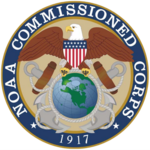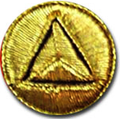
The National Oceanic and Atmospheric Administration is a scientific and regulatory agency within the Washington, D.C.–based United States Department of Commerce, headquartered in Silver Spring, Maryland.
The United States has eight federal uniformed services that commission officers as defined by Title 10 and subsequently structured and organized by Titles 10, 14, 32, 33, and 42 of the U.S. Code.

The Office of Marine and Aviation Operations (OMAO) is a division of the National Oceanic and Atmospheric Administration (NOAA) which operates a wide variety of specialized ships and aircraft to carry out the environmental and scientific missions of NOAA.

The Environmental Science Services Administration (ESSA) was a United States Federal executive agency created in 1965 as part of a reorganization of the United States Department of Commerce. Its mission was to unify and oversee the meteorological, climatological, hydrographic, and geodetic operations of the United States. It operated until 1970, when it was replaced by the new National Oceanic and Atmospheric Administration (NOAA).

A rear admiral in the uniformed services of the United States is either of two different ranks of commissioned officers: one-star flag officers and two-star flag officers. By contrast, in most other countries, the term "rear admiral" refers only to an officer of two-star rank.
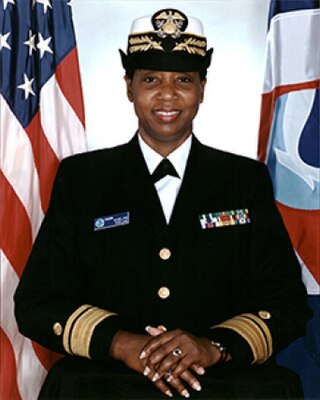
Evelyn J. Fields is a former officer of the National Oceanic and Atmospheric Administration Commissioned Officer Corps, who served as the director of the Commissioned Officer Corps and director of NOAA's Office of Marine and Aviation Operations, from 1999 until her retirement in 2003. Fields was the first woman, and first African American to head the NOAA Corps.
Vice admiral is a three-star commissioned officer rank in the United States Navy, the United States Coast Guard, the United States Public Health Service Commissioned Corps, and the National Oceanic and Atmospheric Administration Commissioned Officer Corps, with the pay grade of O-9. Vice admiral ranks above rear admiral and below admiral. Vice admiral is equivalent to the rank of lieutenant general in the other uniformed services.
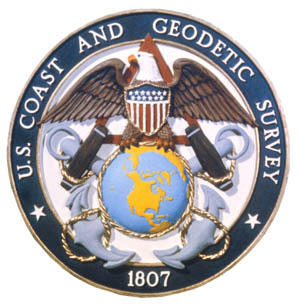
The United States Coast and Geodetic Survey was the first scientific agency of the United States Government. It existed from 1807 to 1970, and throughout its history was responsible for mapping and charting the coast of the United States, and later the coasts of U.S. territories. In 1871, it gained the additional responsibility of surveying the interior of the United States and geodesy became a more important part of its work, leading to it being renamed the U.S. Coast and Geodetic Survey in 1878.

The National Oceanic and Atmospheric Administration Commissioned Officer Corps, one of the eight uniformed services of the United States, has the authority to issue various awards and commendations to its members. These include individual honor awards, unit honor awards, service awards, training ribbons and qualification insignia. NOAA Corps awards and decorations include:
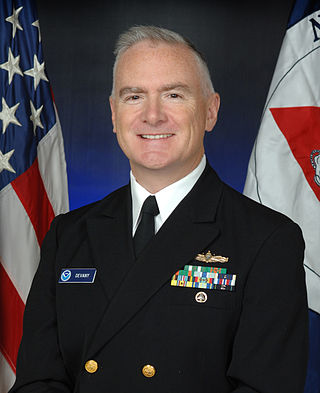
Michael S. Devany is a former vice admiral in the NOAA Commissioned Officer Corps who last served as the deputy under secretary for operations at the National Oceanic and Atmospheric Administration from January 2, 2014 to April 2016. He previously served as director of the NOAA Commissioned Officer Corps from August 13, 2012 to January 1, 2014, succeeding RADM Jonathan W. Bailey. As deputy under secretary for operations, he was NOAA’s chief operating officer. VADM Devany was responsible for the day-to-day management of NOAA’s national and international operations for oceanic and atmospheric services, research, and coastal and marine stewardship. He is a key advisor to the under secretary of commerce for oceans and atmosphere/NOAA administrator on NOAA program and policy issues. Devany was the first NOAA Corps officer to achieve the rank of vice admiral since VADM Henry A. Karo in 1965, and the second NOAA Corps officer overall. Devany retired from NOAA in April 2016 after over 30 years of combined uniformed service.

In the United States Navy, United States Coast Guard, United States Public Health Service Commissioned Corps (USPHS), and National Oceanic and Atmospheric Administration Commissioned Officer Corps, captain is the senior-most commissioned officer rank below that of flag officer. The equivalent rank is colonel in the United States Army, Air Force, Space Force, and Marine Corps.

Rear Admiral Leo Otis Colbert was the third director of the United States Coast and Geodetic Survey and a career officer in the United States Coast and Geodetic Survey Corps, predecessor of the National Oceanic and Atmospheric Administration Commissioned Officer Corps.

Rear Admiral James C. Tison Jr. was an officer in the United States Coast and Geodetic Survey Corps and Environmental Science Services Administration Corps, both predecessors of the National Oceanic and Atmospheric Administration Commissioned Officer Corps. He served simultaneously as the first Director of the ESSA Corps, one of only two people to hold the position, and as the sixth Director of the United States Coast and Geodetic Survey.

Rear Admiral Don A. Jones was an officer in the United States Coast and Geodetic Survey Corps, its successor, the Environmental Science Services Administration Corps, and the ESSA Corps's successor, the National Oceanic and Atmospheric Administration Commissioned Officer Corps. He served simultaneously as the second and last Director of the ESSA Corps, one of only two people to hold the position, and as the seventh and last Director of the United States Coast and Geodetic Survey.

Rear Admiral Harley Dean Nygren was an American military officer who served in the United States Coast and Geodetic Survey Corps, its successor, the Environmental Science Services Administration Corps, and the ESSA Corps's successor, the National Oceanic and Atmospheric Administration Commissioned Officer Corps. He served as the first Director of the NOAA Corps.
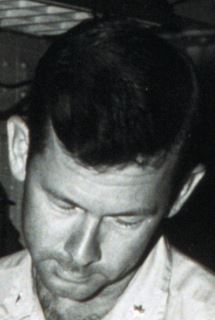
Rear Admiral Kelly E. Taggart was a career officer who served in the United States Coast and Geodetic Survey Corps, its successor, the Environmental Science Services Administration Corps, and the ESSA Corps's successor, the National Oceanic and Atmospheric Administration Commissioned Officer Corps. He served as the second Director of the NOAA Corps.

Rear Admiral Francis D. "Bill" Moran is a retired career officer who served in the United States Coast and Geodetic Survey Corps, its successor, the Environmental Science Services Administration Corps, and the ESSA Corps's successor, the National Oceanic and Atmospheric Administration Commissioned Officer Corps. He served as the third Director of the NOAA Corps.

Rear Admiral Sigmund R. Petersen is a retired career officer who served in the United States Coast and Geodetic Survey Corps, its successor, the Environmental Science Services Administration Corps, and the ESSA Corps's successor, the National Oceanic and Atmospheric Administration Commissioned Officer Corps. He served as the fourth Director of the NOAA Corps.

Michael J. Silah is a retired rear admiral in the National Oceanic and Atmospheric Administration Commissioned Officer Corps who served as Director, NOAA Commissioned Officer Corps, and Director, NOAA Office of Marine and Aviation Operations.
